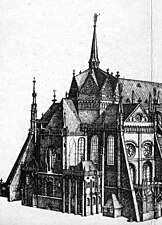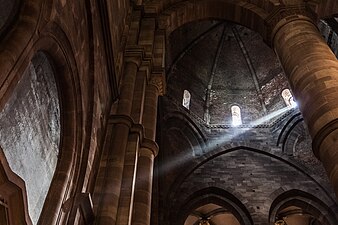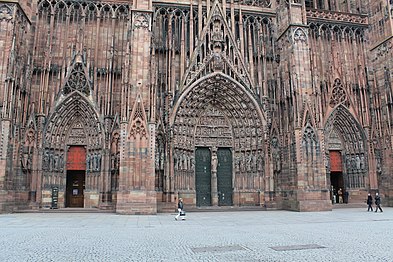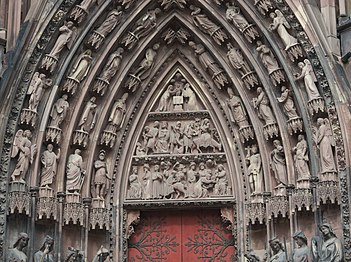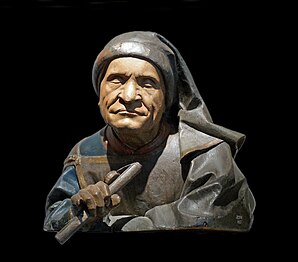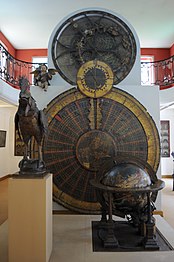Strasbourg Cathedral
Strasbourg Cathedral or the Cathedral of Our Lady of Strasbourg (French: Cathédrale Notre-Dame de Strasbourg, or Cathédrale de Strasbourg, German: Liebfrauenmünster zu Straßburg), also known as Strasbourg Minster (German: Straßburger Münster), is a Catholic cathedral in Strasbourg, Alsace, France. Although considerable parts of it are still in Romanesque architecture, it is widely considered[2][3][4][5] to be among the finest examples of Rayonnant Gothic architecture. Architect Erwin von Steinbach is credited for major contributions from 1277 to his death in 1318, and beyond through his son Johannes von Steinbach, and his grandson Gerlach von Steinbach, who succeeded him as chief architects. The Steinbachs’ plans for the completion of the cathedral were not followed through by the chief architects who took over after them, and instead of the originally envisioned two spires, a single, octagonal tower with an elongated, octagonal crowning was built on the northern side of the west facade by master Ulrich Ensingen and his successor, Johannes Hültz. The construction of the cathedral, which had started in the year 1015 and had been relaunched in 1190, was finished in 1439.[6]
Strasbourg Cathedral
Cathédrale Notre-Dame de Strasbourg
Archbishop Pascal Michel Ghislain Delannoy
Active
Strasbourg, France
1015
1439
Southwest
112 metres (367 ft)
32.6 metres (107 ft) (Nave)
1
58 m (190 ft)
1
142 metres (466 ft)
1862
PA00085015[1]
Église
Standing in the centre of the Place de la Cathédrale, at 142 metres (466 feet), Strasbourg Cathedral was the world's tallest building from 1647 to 1874 (227 years), when it was surpassed by St. Nikolai's Church, Hamburg. Today it is the sixth-tallest church in the world and the tallest extant structure built entirely in the Middle Ages.
Described by Victor Hugo as a "gigantic and delicate marvel",[7] and by Goethe as a "sublimely towering, wide-spreading tree of God",[2] the cathedral is visible far across the plains of Alsace and can be seen from as far off as the Vosges Mountains or the Black Forest on the other side of the Rhine. The reddish-brown sandstone from the Vosges mountains gives the cathedral its distinctive colour.[8]
The construction, and later maintenance, of the cathedral is supervised by the Fondation de l'Œuvre Notre-Dame ("Foundation of Our Lady") since at least 1224.[9] The Musée de l'Œuvre Notre-Dame, a municipal museum located in the Foundation's buildings, displays original works of art from the cathedral, such as sculptures and stained-glass, but also the surviving original medieval buildings plans.
In 1988, the Strasbourg Cathedral was inscribed on the UNESCO World Heritage List along with the historic centre of the city (called the "Grande Île") because of its outstanding Gothic architecture.[10]
Tapestries[edit]
The cathedral has a group of fourteen tapestries depicting the life of the Virgin Mary. They were commissioned by Cardinal Richelieu for the Cathedral of Notre Dame de Paris, and were made to accompany a painting there, "The Vow of Louis XIII". They were manufactured between 1638 and 1657 in Paris by Pierre Damour. They were purchased by the Chapter of Strasbourg Cathedral in 1739, and were an example of the importation of the French style of that period into Alsace. They are traditionally hung in the arcades of the nave during Advent.[88]
The Musée de l'Œuvre Notre-Dame, or Museum of the Work of Notre-Dame, is located in a medieval and Renaissance building not far from the cathedral, and displays a collection of some of the most delicate original works of sculpture and art from Cathedral, moved there to protect them from environmental damage. These include some of the original statues from the portals and façade dating from the 13th century, including the statues of "The Church" and "The Synagogue" from the portal of the south transept. The statue of the "Synagogue" is blindfolded, since Jews did not recognise the divinity of Christ. It also preserves the earliest plans of the cathedral, as well as paintings and tapestries and other objects.
Other objects and works from the cathedral, including the mechanism of the original astronomical clock, are found in the Musée des arts décoratifs de Strasbourg.
The known dimensions of the building are as follows:[89]
Furnishing[edit]
Protestant and Revolutionary iconoclasm, the war periods of 1681, 1870 and 1940–1944, as well as changes in taste and liturgy, have taken a toll on some of Strasbourg Cathedral's most outstanding features such as the choir screen of 1252 and the successive high altars (ca. 1500 and 1682), but many treasures remain inside the building; others, or fragments of them, being displayed in the Musée de l’Œuvre Notre-Dame.
